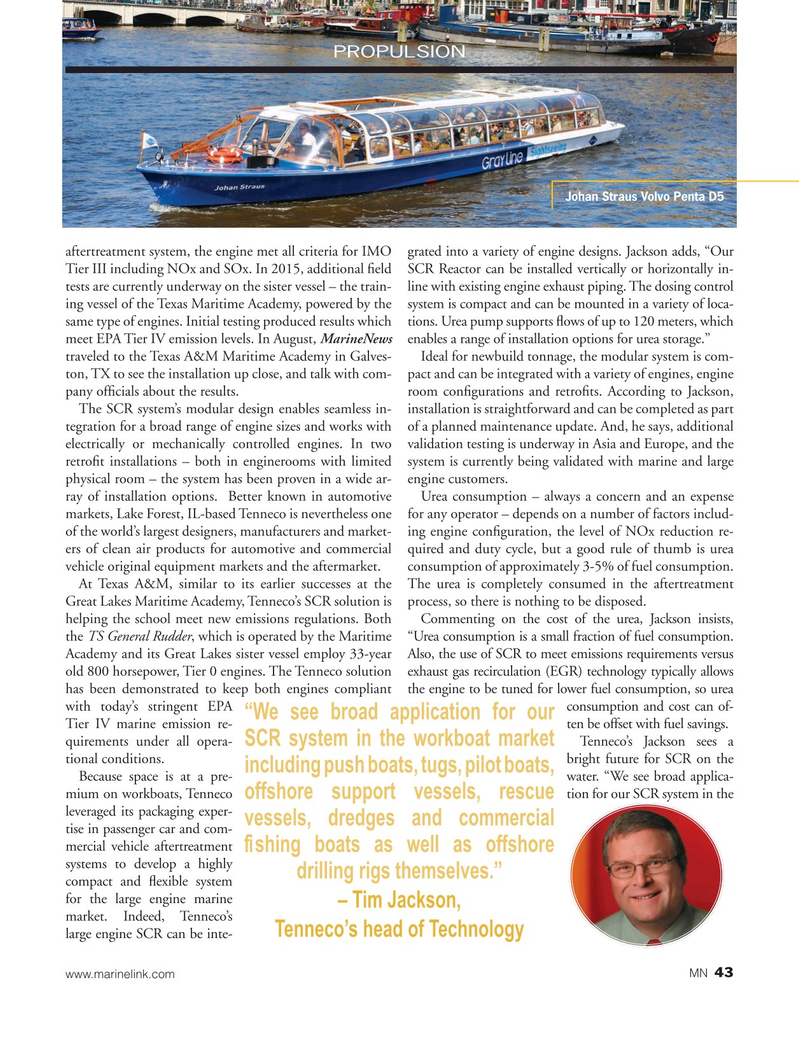
Page 43: of Marine News Magazine (October 2015)
Salvage & Spill Response
Read this page in Pdf, Flash or Html5 edition of October 2015 Marine News Magazine
PROPULSION
Johan Straus Volvo Penta D5 aftertreatment system, the engine met all criteria for IMO grated into a variety of engine designs. Jackson adds, “Our
Tier III including NOx and SOx. In 2015, additional ? eld SCR Reactor can be installed vertically or horizontally in- tests are currently underway on the sister vessel – the train- line with existing engine exhaust piping. The dosing control ing vessel of the Texas Maritime Academy, powered by the system is compact and can be mounted in a variety of loca- same type of engines. Initial testing produced results which tions. Urea pump supports ? ows of up to 120 meters, which meet EPA Tier IV emission levels. In August, MarineNews enables a range of installation options for urea storage.” traveled to the Texas A&M Maritime Academy in Galves- Ideal for newbuild tonnage, the modular system is com- ton, TX to see the installation up close, and talk with com- pact and can be integrated with a variety of engines, engine pany of? cials about the results. room con? gurations and retro? ts. According to Jackson,
The SCR system’s modular design enables seamless in- installation is straightforward and can be completed as part tegration for a broad range of engine sizes and works with of a planned maintenance update. And, he says, additional electrically or mechanically controlled engines. In two validation testing is underway in Asia and Europe, and the retro? t installations – both in enginerooms with limited system is currently being validated with marine and large physical room – the system has been proven in a wide ar- engine customers.
ray of installation options. Better known in automotive Urea consumption – always a concern and an expense markets, Lake Forest, IL-based Tenneco is nevertheless one for any operator – depends on a number of factors includ- of the world’s largest designers, manufacturers and market- ing engine con? guration, the level of NOx reduction re- ers of clean air products for automotive and commercial quired and duty cycle, but a good rule of thumb is urea vehicle original equipment markets and the aftermarket. consumption of approximately 3-5% of fuel consumption.
At Texas A&M, similar to its earlier successes at the The urea is completely consumed in the aftertreatment
Great Lakes Maritime Academy, Tenneco’s SCR solution is process, so there is nothing to be disposed. helping the school meet new emissions regulations. Both Commenting on the cost of the urea, Jackson insists, the TS General Rudder, which is operated by the Maritime “Urea consumption is a small fraction of fuel consumption.
Academy and its Great Lakes sister vessel employ 33-year Also, the use of SCR to meet emissions requirements versus old 800 horsepower, Tier 0 engines. The Tenneco solution exhaust gas recirculation (EGR) technology typically allows has been demonstrated to keep both engines compliant the engine to be tuned for lower fuel consumption, so urea with today’s stringent EPA consumption and cost can of- “We see broad application for our
Tier IV marine emission re- ten be offset with fuel savings. quirements under all opera- Tenneco’s Jackson sees a
SCR system in the workboat market tional conditions. bright future for SCR on the including push boats, tugs, pilot boats,
Because space is at a pre- water. “We see broad applica- mium on workboats, Tenneco tion for our SCR system in the offshore support vessels, rescue leveraged its packaging exper- vessels, dredges and commercial tise in passenger car and com- mercial vehicle aftertreatment ? shing boats as well as offshore systems to develop a highly drilling rigs themselves.” compact and ? exible system for the large engine marine – Tim Jackson, market. Indeed, Tenneco’s
Tenneco’s head of Technology large engine SCR can be inte- 43 www.marinelink.com MN
MN Oct15 Layout 32-49.indd 43 9/21/2015 11:26:32 AM

 42
42

 44
44
